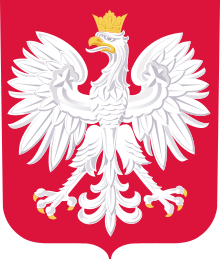Poland–Spain relations
 |
|
Poland |
Spain |
|---|---|
Poland–Spain relations are cultural and political relations between Poland and Spain. Their history dates to Late Middle Ages. Currently, both countries are often found to be political partners in the European Union.
Historical relations
First contact between the Kingdoms of Poland and Spain date to Late Middle Ages, where merchants, travelers and priests (Jesuits) traveled between both countries. Early Polish diplomats in Spain in the 16th century included Johannes Dantiscus and Piotr Dunin-Wolski.[1][2]
While the Polish and Spanish forms of governments evolved in a different direction, the diplomacy of both countries was more likely to support one another than not.[3][4] Spain was the only country to express a protest over the First Partition of Poland, and in 1795, following the final Third Partition of Poland, Spanish diplomat Don Domingo de Yriarte was one of the last foreign diplomats to vacate his post in Warsaw.[4]
During the Peninsular War (1809–1814) in Spain, a number of Polish soldiers fought on the side of Napoleon. The Vistula Legion gained fame at the Battle of Zaragoza.[5] The Polish Chevau-léger regiment distinguished itself at the Battle of Somosierra in 1808[4]
In the early 20th century a number of Polish volunteers participated in the Spanish Civil War on the Republican side, with the most famous unit being the Dabrowski Battalion.[6][7]
Current foreign relations
Poland and Spain established diplomatic relations in 1919, in the aftermath of World War I.[8] Full diplomatic relations after World War II were only established in 1977, as the government of the People's Republic of Poland refused to recognize the Falangist government of General Francisco Franco.[8]
After the Autumn of Nations and formation of a new, non-communist Polish government, both countries signed a Treaty of Friendship and Cooperation in 1992.[8] In 1998, both countries signed a Common Polish-Spanish Declaration.[8] Since 2003, irregular bilateral conferences between prime ministers of both nations take place; as of 2012 eight such meetings have taken place.[8][9]
Both countries are member of the European Union, and their relations have been often described as very good and close, particularly in the context of EU internal politics.[10][11]
The Polish minority in Spain numbers about 130,000-150,000.[8]
Cultural relations
Certain ties in Polish and Spanish cultures can be explained by the fact that Poland and Spain had the highest percentage of petty nobility in Europe (hidalgos, szlachta), which encouraged ties between educated elites, and mutual references.[3][12] Even more importantly, both countries also shared a strong Catholic history, on the frontier of struggles against the Muslims (Antemurale Christianitatis, Reconquista).[3]
Spain had a significant influence on Polish culture, particularly literature.[3][4] Spanish works have been translated into Polish, Spain was a setting of some famous Polish works such as The Manuscript Found in Saragossa, and influenced major Polish literary figures, such as Juliusz Słowacki.[13]
In the 21st century both governments promoted their partner's culture at home, with the Polish Year in Spain in 2002 and the Spanish Year in Poland in 2003.[11][14] Spain is a popular tourist destination for Poles, with about half a million of Poles visiting Spain each year.[11] Spanish language is a popular foreign language to learn in Poland.[11]
Economic relations
At the end of 2011, biltateral trade relations between both countries amounted to €6.15 Bn.[8] Spain is the eleventh largest foreign investor in Poland, with investments valued at €4 Bn.[8]
See also
Notes
- ↑ Harold B. Segel (1989). Renaissance Culture in Poland: The Rise of Humanism, 1470-1543. Cornell University Press. pp. 175–176. ISBN 978-0-8014-2286-7. Retrieved 24 October 2012.
- ↑ Adam Kucharski (1 January 2007). Hiszpania i Hiszpanie w relacjach Polaków: wrażenia z podróży i pobytu od XVI do początków XIX w. Wydawnictwo Naukowe Semper. p. 117. ISBN 978-83-7507-022-4. Retrieved 24 October 2012.
- 1 2 3 4 Marek Jan Chodakiewicz; John Radzilowski (2003). Spanish Carlism and Polish Nationalism: The Borderlands of Europe in the 19th and 20th Centuries. Transaction Publishers. p. 46. ISBN 978-0-9679960-5-9. Retrieved 24 October 2012.
- 1 2 3 4 Marek Jan Chodakiewicz; John Radzilowski (2003). Spanish Carlism and Polish Nationalism: The Borderlands of Europe in the 19th and 20th Centuries. Transaction Publishers. p. 47. ISBN 978-0-9679960-5-9. Retrieved 24 October 2012.
- ↑ George Nafziger and Tad J. Kwiatkowski, The Polish Vistula Legion. Napoleon. No. 1 : January 1996
- ↑ "Dąbrowszczacy". IPN. Retrieved 24 October 2012.
- ↑ "A Telling "Omission"". Osaarchivum.org. Retrieved 2012-10-24.
- 1 2 3 4 5 6 7 8 "Hiszpania" (in Polish). Msz.gov.pl. Retrieved 2012-10-24.
- ↑ "Kontakty polityczne" (in Polish). Madryt.msz.gov.pl. Retrieved 2012-10-24.
- ↑ http://www.nytimes.com/2006/03/09/world/europe/09iht-poland-5834138.html
- 1 2 3 4 "KPRM zasoby archiwalne". Poprzedniastrona.premier.gov.pl. 2003-11-24. Retrieved 2012-10-24.
- ↑ Norman Davies (1996). Europe: A History. Oxford University Press. p. 584. ISBN 978-0-19-820171-7. Retrieved 24 October 2012.
- ↑ Marek Jan Chodakiewicz; John Radzilowski (2003). Spanish Carlism and Polish Nationalism: The Borderlands of Europe in the 19th and 20th Centuries. Transaction Publishers. p. 48. ISBN 978-0-9679960-5-9. Retrieved 24 October 2012.
- ↑ "Kultura i nauka" (in Polish). Msz.gov.pl. Retrieved 2012-10-24.
Further reading
- Gabriela Makowiecka, Po drogach polsko-hiszpańskich, Wydawnictwo Literackie, Kraków, 1984
External links
- Bak, Grzegorz, La imagen de España en la literatura polaca del siglo XIX [Recurso electrónico] : (diarios, memorias, libros de viajes y otros testimonios literarios) / Grzegorz Bak ; director, Fernando Presa González, Madrid: Universidad Complutense de Madrid, Servicio de Publicaciones, 2004
- BIBLIOGRAFÍA DE INTERÉS HISPANO-POLACO. En la biblioteca Guillermo Cabrera Infante (Instituto Cervantes de Varsovia)
- Beata Wojna, Stosunki polsko-hiszpańskie w Unii Europejskiej, Biuletyn PISM, nr 18 (263), 2005-03-03
- Polonia.es - page of the Polish minority in Spain
- Bilateral cooperation, Polish Embassy in Madrit, Spain

.svg.png)